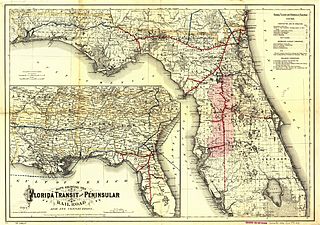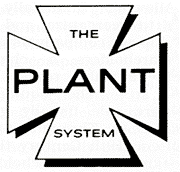The Atlantic, Suwannee River and Gulf Railroad Company was a railroad that ran westward from Starke, Florida, eventually terminating at Wannee, Florida, on the Suwannee River. It was later absorbed by the Seaboard Air Line Railroad becoming their Wannee Subdivision.

The South Florida Railroad was a railroad from Sanford, Florida, to Tampa, Florida, becoming part of the Plant System in 1893 and the Atlantic Coast Line Railroad in 1902. It served as the southernmost segment of the Atlantic Coast Line's main line. The line remains in service today and is now part of the Central Florida Rail Corridor in the Orlando metro area. The rest of the line remains under the ownership of CSX Transportation as part of their A Line.
The Florida Northern Railroad Company, Inc. is one of several short line railroads run by Regional Rail, LLC. It has connections to CSX at Ocala, Florida, running north to Lowell, Florida, and south to Candler, Florida. It was formerly run by CSX as their Ocala Subdivision.

The Florida Central and Peninsular Railroad was the final name of a system of railroads throughout Florida, becoming part of the Seaboard Air Line Railway in 1900. The system, including some of the first railroads in Florida, stretched from Jacksonville west through Tallahassee and south to Tampa. Much of the FC&P network is still in service under the ownership of CSX Transportation.

The Plant System, named after its owner, Henry B. Plant, was a system of railroads and steamboats in the U.S. South, taken over by the Atlantic Coast Line Railroad in 1902. The original line of the system was the Savannah, Florida and Western Railway, running across southern Georgia. The Plant Investment Company was formed in 1882 to lease and buy other railroads and expand the system. Other major lines incorporated into the system include the Savannah and Charleston Railroad and the Brunswick and Western Railroad.

Withlacoochee State Trail is a 46-mile (74 km) long paved, multi-use, non-motorized rail trail in Florida located in Citrus, Hernando and Pasco counties. It follows along the Withlacoochee River and passes through the Withlacoochee State Forest. It is the longest paved rail trail in Florida.
The Florida Railroad was the first railroad to connect the east and west coasts of Florida, running from Fernandina to Cedar Key. The line later became part of the Seaboard Air Line Railroad, and, where still in use, is operated by CSX Transportation and the First Coast Railroad. The highway corridor of SR 24, US 301, and SR A1A/SR 200 closely parallels the former Florida Railroad.
The Florida Southern Railway was a railroad that operated in Florida in the late 1800s. It was one of Florida's three notable narrow gauge railway when it was built along with the South Florida Railroad and the Orange Belt Railway. The Florida Southern was originally chartered to run from Lake City south through central Florida to Charlotte Harbor. However, with the influence of Henry B. Plant, it operated with two discontinuous segments that would be part of the Plant System, which would later become part of the Atlantic Coast Line Railroad.
The Jacksonville & Southwestern Railroad (J&SW) was a railroad that served Florida from 1899 to 1904. It was purchased by the Atlantic Coast Line Railroad in 1904. The Atlantic Coast Line would extend the line further west and it would become their Jacksonville—Wilcox Line. Some of the original right-of-way was converted to a recreational path in the rails to trails program in the 1990s.
CSX Transportation's Brooksville Subdivision is a railroad line in the Tampa Bay region of Florida. Today, the line runs from the Clearwater Subdivision in Sulphur Springs, Florida north to a point just north of Brooksville, a distance of 49.1 miles. Historically, the Brooksville Subdivision was owned and operated by CSX predecessor, the Seaboard Air Line Railroad. Under Seaboard ownership, the Brooksville Subdivision continued north as far as Waldo, where it intercepted the Seaboard Air Line main line.
CSX Transportation's Valrico Subdivision is a railroad line in Central Florida. It serves as CSX's main route through a region of Central Florida known as the Bone Valley, which contains the largest known deposits of phosphate in the United States.
The Wildwood Subdivision is a railroad line owned by CSX Transportation in Florida. It runs along CSX's S Line from Baldwin south to Zephyrhills via Ocala and Wildwood for a total of 155.7 miles. The S Line is CSX's designation for the line that was the Seaboard Air Line Railroad main line from 1903 to 1967.
The Tampa and Thonotosassa Railroad was a 13-mile railroad line running from Tampa, Florida northeast to Thonotosassa. The line began operation in 1893 and began at a junction with the South Florida Railroad in Tampa. The line had a station in Thonotosassa. The line was bought out by the Plant System in 1901 which was then sold to the Atlantic Coast Line Railroad in 1902.
The Atlantic Coast Line Railroad's Perry Cutoff was a historic rail line in northern Florida running from Monticello southeast to Perry. The line provided a shortcut for rail traffic running between the Midwest and the Tampa Bay area by providing a more direct route and a bypass for the busy rail hub in Jacksonville. It was completed in 1928 to reduce travel times for its passenger trains to the west coast, or Gulf Coast, of Florida during the Florida land boom of the 1920s.
The Live Oak, Tampa and Charlotte Harbor Railroad was a historic railroad in Florida chartered by railroad tycoon Henry B. Plant. It was built as an extension of Plant's Live Oak and Rowlands Bluff Railroad. Together, the two lines ran from Live Oak, Florida to Gainesville via High Springs. The lines were completed in 1884.

The Atlantic Coast Line Railroad’s Main Line was the backbone of the Atlantic Coast Line Railroad's network in the southeastern United States. The main line ran from Richmond, Virginia to Port Tampa just southwest of Tampa, Florida, a distance of nearly 900 miles. Along its route it passed through Petersburg, Rocky Mount, Florence, Charleston, Savannah, Jacksonville, and Orlando. With the exception of a short 61-mile segment in Greater Orlando, the entire line is still owned by the Atlantic Coast Line's successor, CSX Transportation, and is still in service as their A Line.
The Atlantic Coast Line Railroad's Lakeland—Fort Myers Line was one of the railroad company's secondary main lines in Central and Southwest Florida. It was built incrementally in the late 1800s and early 1900s. Parts of the line are still active today.
The Atlantic Coast Line Railroad's DuPont—Lakeland Line was a historic rail line in southern Georgia and the northern west coast of Florida. On employee timetables, the line was actually divided into the DuPont—High Springs Line and the High Springs—Lakeland Line. The line was primarily used for freight, though some passenger services ran on parts of it in Florida. While parts of the line were built as early as 1863, the full line was not complete until 1913. Parts of the line in Florida are still active today.
The Seaboard Air Line Railroad’s Main Line was the backbone of the Seaboard Air Line Railroad's network in the southeastern United States. The main line ran from Richmond, Virginia to Tampa, Florida, a distance of over 800 miles. Along its route it passed through Petersburg, Raleigh, Columbia, Savannah, Jacksonville, and Ocala, Florida. While some segments of the line have been abandoned as of 2022, most of the line is still in service and is owned by the Seaboard Air Line's successor, CSX Transportation as their S Line.
The Atlantic Coast Line Railroad's High Springs—Croom Line was a historic rail line in northern Florida. The line dates back to the late 1800s and was used for both passengers and freight.





